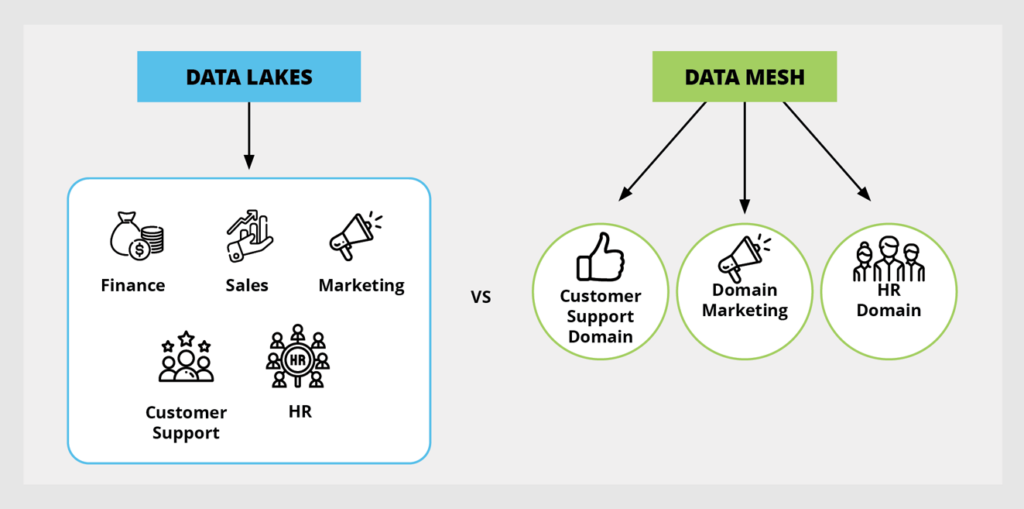Effective data management is crucial for businesses today, especially with the increased flow of data and the number of data sources. Data management ensures data safety and security as it flows within an organization while maximizing the value of the data. Businesses traditionally ingest data into centralized data stores like data lakes, which can handle today’s enormous volumes and complex digital landscape. However, ensuring proper data management becomes a Herculean task as data volumes and sources grow.
A decentralized data design approach like the data mesh has become promising for solving data management issues arising from centralized data systems like your data lakes. A data mesh takes a decentralized and democratized approach to data storage and organization whereby there is a single source of truth for data and organizational data across multiple domains as data products.
This article explores how data lake architecture and data mesh differ in how they operate and offer business value and how a synergy between both may work, depending on your business needs.
How To Compare Data Lake vs. Data Mesh
In truth, a direct comparison between data lakes and data mesh may not provide a clearer picture as one is data storage, whereas the other represents a shift in design thinking. It’s like comparing architecture to bay windows; bay windows are an architectural feature (data lakes), whereas architecture is the design of a structure (data mesh). However, one can observe how they both affect data management within an organization and how they can work together to provide you with a robust data architecture that serves your business needs.
The Philosophy of Data Lake vs. Data Mesh
To better compare these two approaches, we can observe what principles guide their approach to managing data flow and management within an organization.
Centralized vs. Distributed Architecture and Governance
Data lakes are monolithic, centralized data architectures that ingest and collate all organizational data and act as a single source of truth for business operations. Data lakes have become popular as they’re a cost-effective solution and can house various types of data (structured, semi-structured, and unstructured) for serving diverse business use cases like analytics, ML, and data science tasks. However, the data lakes’ ability to ingest and store massive volumes of data of all types makes them susceptible to becoming a data swamp; hence it requires proper data management to ensure data safety and security, which can be challenging.
Additionally, domains existing within the organization that need access to their organizational data often need to go through vast volumes of data before accessing their relevant domain data, increasing time to data access and insights and slowing business decision-making. However, most organizations now employ data catalogs as part of their data governance efforts while implementing a data lake which counteracts this concern. Data catalogs enrich organizational data sets with metadata to create high-quality and auditable data assets that are discoverable, trustworthy, high-quality, and secure for their data users. An example is the Databricks Unity Catalog, which provides unified governance for data and AI on the lakehouse, enabling data scientists, analysts, and engineers to discover, access, and collaborate on assets.
The data mesh takes another approach by breaking down extensive, monolithic data into multiple, smaller domains that produce data products. A data mesh might involve implementing several data lakes, each serving a business use case. Domains represent various teams/departments making up the business. For example, your e-commerce business may have domains like finance, sales, marketing, and customer support working together to drive your daily operations.
A domain expert called the domain product owner manages every domain, and each domain has complete, autonomous control of its domain for making data governance decisions regarding the data. However, every domain follows a set standard when establishing its policies to enable the development of independent and consistent but interoperable products that offer business value across the entire organization. The data mesh operates by making those closest to and in need of the data (domain experts) accountable for the data, hence hastening the time to access and insights, driving faster business operations.

Self-Service vs. Developer-Managed Service
Data lakes require highly specialized hands and a central team to ensure proper data management. However, the central engineering teams may lack the domain knowledge needed to adequately serve data that best handle diverse business use cases, leading to underutilizing your business data. Additionally, the need for highly specialized hands to properly manage the centralized data limits access, stifling productivity and digital innovation.
On the other hand, data mesh employs a self-service infrastructure for developing its data platforms. The self-service infrastructure is domain-agnostic and confers domains with the self-sufficiency to find, understand, and consume their domain data without being highly-specialized technologists. Using these self-service platforms removes development complexity and ensures the autonomous use of these platforms for developing and managing secure, interoperable applications.
Data as a Product vs. Data As Tables and Rows
A data mesh consists of multiple nodes or domains; each domain contains a data product managed by data product owners but is interconnected and must be interoperable. Data mesh employs product thinking for designing its data products and aims to deliver discoverable and easily usable data assets that consumers can access and consume without being highly specialized. Each domain product is available for users to consume via channels like APIs and datasets.
Data lakes ingest data from multiple sources in different formats for storage. For example, a data lake ingests relational database data tables as rows and columns and semi-structured data as delimited text files. It stores them in native formats like Parquet and Avro. Data lakes mostly deliver data as a service, heavily relying on specialized analysts to consume the data, extract insights, and make them understandable via spreadsheets or other forms of visualization to business stakeholders and decision-makers.
Data Lakes and Data Meshes Summarized
Most businesses with large volumes of data use a data lake as their central repository to store and manage data from multiple sources. However, the growing volume and varied nature of data in data lakes makes data management challenging, particularly for businesses operating with various domains. This is where a data mesh approach can tie in to your data management efforts.
The data mesh is a microservice, distributed approach to data management whereby extensive organizational data is split into smaller, multiple domains and managed by domain experts. The value provided by implementing a data mesh for your organization includes simpler management and faster access to your domain data.
By building a data ecosystem that implements a data lake with data mesh thinking in mind, you can grant every domain operating within your business its product-specific data lake. This product-specific data lake helps provide cost-effective and scalable storage for housing your data and serving your needs. Additionally, with proper management by domain experts like data product owners and engineers, your business can serve independent but interoperable data products.
How StreamSets Helps You Connect Any Architecture
Your approach to designing your data ecosystem depends on numerous factors and severely affects data management. A growing business with few domains may want to utilize the centralized solution offered by data lakes, while a large organization serving multiple use cases may benefit from the microservices, distributed approach offered by data meshes.
In either case, StreamSets enable you to build your monolithic data lakes or separate, interconnected data lakes for your data ecosystem. As a cloud-agnostic Data Integration platform, StreamSets uses its cloud data lake integration to develop robust, flexible multi-cloud data lakes atop several cloud providers like Azure DataLake, Databricks, and others.
Frequently Asked Questions
What is the difference between a data lake and a data mesh?
A data lake is a centralized storage repository that ingests and stores structured, unstructured, and semi-structured data. It is a cost-effective and scalable storage solution that serves data processing for analytics, ML, and data science tasks. A data mesh design approach decentralizes how organizations store and access their data by creating multiple domains and granting access to those closest to the data to manage and consume the data correctly.
Does data mesh replace data lake?
A data mesh is not a replacement for the data lake but, instead, can improve on the already existing capabilities of the data lake. By applying the data mesh approach when building your data lakes, your organization can create smaller, more manageable, and easily accessible product-specific data lakes that serve interoperable and consumer-facing data products.
The post Why Data Mesh vs. Data Lake Is a Broader Conversation appeared first on StreamSets.


